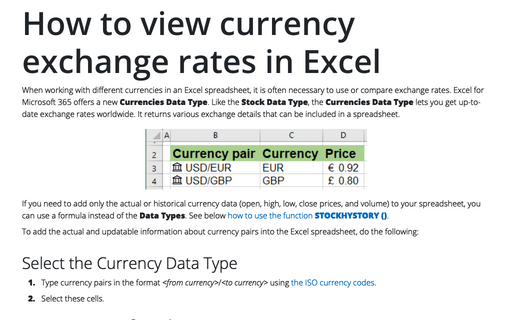How to view geography information in Excel

To add the actual and updatable information about geographic regions into the Excel spreadsheet, do the following:
Select the Geography Data Type
1. Type the names of geographical regions such as countries or cities.
2. Select these cells.
For example:

3. On the Data tab, in the Data Types group, select Geography from the gallery by doing one of the following:
- Click the More button, then choose Geography:

- Click the Down button and choose Geography:

Excel will try to convert the selected text to the Geography data type. If the transformation was successful (Excel found in the Microsoft online source a matching geographical data for the value in the cell), the cell data have the geography icon ![]() :
:

Notes:
- If you select multiple data cells, Excel treats them as the same type. Thus, Excel understands all the data selected in this case as countries despite the fact that Georgia is not only a country but also a US state and counties in some states.
- Suppose you define such records (in this example, the cell with Georgia) as a geographic data type separately from the rest of the cells. In that case, Excel cannot find the corresponding inventory record in Microsoft online sources:

It can happen due to spelling mistakes, and Excel needs your help interpreting the geographical region correctly. In this case, click on the question icon
 to open the Data Selector pane:
to open the Data Selector pane:

- Modify the name in the field on the top if there is a spelling error, and click the find icon
 .
. - Select the appropriate data if there are several records for this geographical region.
Add the geographical information
4. Select one or more cells with the Geography data type
(with the geography icon ![]() ) and click the Insert Data button
) and click the Insert Data button ![]() :
:

From the drop-down list, select the data that you want to add to the spreadsheet.
5. Click the Insert Data button again and add more data columns.
For example:

Notes:
- To see all of the fields available for a geographical region, click the geography icon
 or select the cell and press Ctrl+Shift+F5:
or select the cell and press Ctrl+Shift+F5:

The information provided differs for different geographical objects: countries, cities, counties, etc.
- To refresh data type, do one of the following:
- On the Data tab, in the group Queries & Connections, click the Refresh All button:

- Right-click the geography data (cells with geography icon
 ) and choose Data Type -> Refresh in the popup menu:
) and choose Data Type -> Refresh in the popup menu:

This command refreshes all data types in the workbook (stock, currencies, geography, etc.), not just the current spreadsheet!
- On the Data tab, in the group Queries & Connections, click the Refresh All button:
- To change the Geography data, right-click on the cell with this data type you want to change (cells with icon
 ) and choose Data Type -> Change... in the popup menu.
) and choose Data Type -> Change... in the popup menu.
This command opens the Data Selector pane to type or select another data (see how to work in this pane above).
The Change... command in the popup menu is available if you select only one Geography data element.
- To fix or change the Geography data type to the regular text, right-click on the the data that you want to fix (cells with geography icon
 ), then choose Data Type -> Convert to Text in the popup menu.
), then choose Data Type -> Convert to Text in the popup menu.
This command converts the Geography data type to the regular text, and all dependent data won't be shown anymore:

To save all dependent data, before converting the Geography data type, do the following:
- Select all dependent data that you want to save and copy it to the Clipboard (by clicking the Copy button on the Home tab, in the Clipboard group, or by pressing Ctrl+C).
- On the Home tab, in the Clipboard group, click Paste, and then select one of the Paste Values buttons:

 Values (V) pastes the results of formulas. The destination for the copy can be a new or the original range. In the latter case, Excel replaces the original formulas with their current values
Values (V) pastes the results of formulas. The destination for the copy can be a new or the original range. In the latter case, Excel replaces the original formulas with their current values Values & Number Formatting (A) pastes the results of formulas, plus the number formatting
Values & Number Formatting (A) pastes the results of formulas, plus the number formatting Values & Source Formatting (E) pastes the results of formulas, plus all formatting.
Values & Source Formatting (E) pastes the results of formulas, plus all formatting.
- To work with geography information, you need online Internet access and an appropriate Excel version of Microsoft 365.


